Arlington
No ruminations about pandemics this morning, or anything else, for that matter. Kenneth Scott Bates, Captain, USN-Ret., aka Mr. Sluggo, aka Scotty, will be laid to rest this morning at Arlington National Cemetery, and that is what I am going to fix my concentration.
We can get back to other stuff tomorrow. For now, I will leave you with this memory from the Amen Corner last night, just before the Finance Committee meeting…
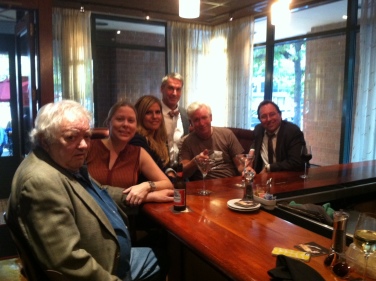
Copyright 2014 Vic Socotra
www.vicsootra.com
Twitter: @jayare303
What Do We Do Now?
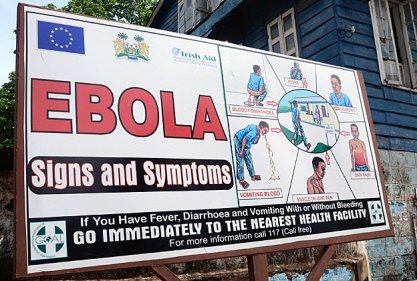
I am sure you saw the actual video tape, though we have known this was coming. President Obama has announced a plan to deploy up to 3,000 US Military personnel to combat the outbreak of the deadly Ebola disease in West Africa. Those forces will require a unique fusion of medical and force protection intelligence to accomplish their mission.
As President Obama announced in mid-September of 2014, combating the outbreak:
“…is a top national security priority for the United States. In order to contain and combat it, we are partnering with the United Nations and other international partners to help the Governments of Guinea, Liberia, Sierra Leone, Nigeria, and Senegal respond just as we fortify our defenses at home. Every outbreak of Ebola over the past 40 years has been contained, and we are confident that this one can – and will be – as well.”
The announced strategy is predicated on four key goals:
· Control of the epidemic at its source in West Africa;
· Mitigating second-order impacts, including blunting the economic, social, and political tolls in the region;
· Engaging and coordinating with a broader global audience; and
· Fortifying global health security infrastructure in the region and beyond.
In order to accomplish these missions, plus the unstated but vital force protection issue and Indications and Warnings of attempts to “weaponize” the disease by deliberate attempts to export the contagion, a new and comprehensive communications architecture and analytic and medical intelligence support is necessary for mission accomplishment. In addition to command and control, logistics expertise, training, and engineering support, all-source intelligence support is required to support the mission.
One focus will of course be the Joint Force Command, a component of US Africa Command, headquartered in Monrovia, Liberia. This central node will provide on-site regional command and control support to US military activities and facilitate coordination with US government and international relief efforts, which will involve an estimated 3000 US forces. Effective connectivity with the national, regional and international elements in effective response is necessary immediately.
The Threat Vector
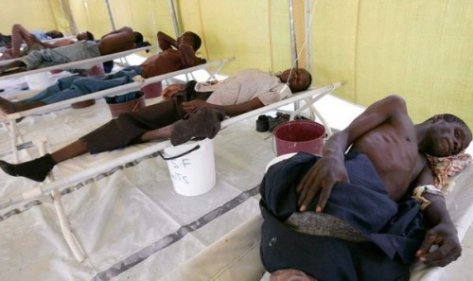
Ebola is an infectious and often fatal disease that results in fever and severe internal bleeding. There are no medications effective in curing the virus, but supportive hospital care can significantly increase survival. Ebola is highly contagious through infected bodily fluids like sweat, blood, and saliva and remains infectious even after the victim has died.
It is a daunting dramatic threat to a region with underdeveloped health resources, crushing poverty and a legacy of decades of armed conflict.
In the US, Response to public health emergencies is provided by a sector-based approach shared between the Department of Health and Human Services and its components (Center for Disease Control (CDC) National Institutes of Health, et al), State, local, tribal, and territorial levels of government.
This structure generally corresponds to the scales on which emergencies generally occur. On the one hand, the complex and dispersed nature of the sector makes it difficult to disable the entire nationwide system. On the other hand, this presents challenges in coordinating emergency responses across disciplines, regions, and levels of government- a fact that is exacerbated by the fact that this is a military response, out of the Continental US, and conducted in the face of multiple al Qaida affiliates in the region, the prime one being Boko Haram, but with other regional terror organizations also playing a role in the force protection problem.
The prospect of American Boots on the Ground this presents a multi-faceted threat environment in which effective warning must fuse together two related but quite different disciplines: all-source intelligence threat Indications and Warning, and classic methods of epidemiology.
All-Source Analysis
Intelligence products and/or organizations and activities that incorporate all sources of information, most frequently including human resources intelligence, imagery intelligence, measurement and signature intelligence, signals intelligence, geo-spatial information and open-source data in the production of finished intelligence. Additionally, “pattern of life” and other socio-cultural aspects of the all-source picture must be integrated in any comprehensive intelligence solution. Experience in supporting tactical units in Afghanistan clearly demonstrates that augmentation to forces in the field is the most effective means of improving mission accomplishment. Collection management support to the analytic process is absolutely essential in the development of spiral response to evolving situations.
Epidemiology
Epidemiology is the study of patterns, causality and effect of disease on public health in defined populations, which in the case of Ebola crosses national and ethnic boundaries. It is the cornerstone of public health response to epidemics, and informs policy by identifying risk factors and means of prophylaxis to them. In the case of the Ebola outbreak, sentinel data collection is one of a number of assessment tools to identify, catalogue and sequester threat vectors for infection. Using statistical analysis and direct observation, a variety of clinical approaches to define best course of treatment and likely drug therapy will result in managing the crisis, which is spreading in a region battered by civil strife and terrorist insurgencies against post-colonial nation states. Major areas of epidemiological study include disease etiology, transmission mechanisms, outbreak tracking, investigation and clinical investigation to better understand how Ebola processes and the means to break the cycle of infection and the proximate and distal causes to break the chain.
The two disciplines- one medical and the other intelligence- employ similar and parallel methodologies. Our solution brings them together in close coordination.
Why an Integrated Response is Necessary
The Great Pandemic, 1918
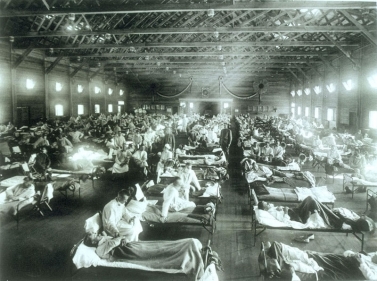
(Army hospital at the height of the influenza pandemic. Photo US Army)
The US Government has confronted global medical emergencies before. Perhaps the most deadly of them- and a cautionary one in the context of the emerging Ebola Crisis- was the great influenza pandemic of 1918-1919. “Spanish Flu,” or “Grippe” killed more people than the total lost in World War I, at somewhere between 20 and 40 million people. It has been cited as the most devastating epidemic in recorded world history.
In America, An estimated 675,000 perished from a population of only slightly over 103 million. Of the U.S. soldiers who died in Europe, an estimated 43,000 servicemen died of the Flu.
While the pandemic passed, it remains the nightmare public health scenario: easily communicated, rapidly spread and highly lethal.
A Proposed Response
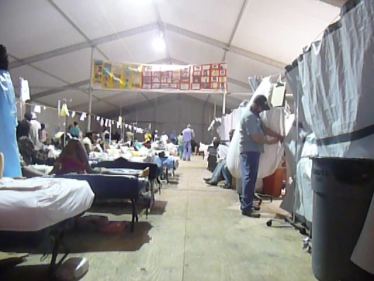
To summarize, AFRICOM has been directed to deploy a JTF headquarters, build and operate a logistics base (the ISB), build a hospital and other treatment facilities, conduct training for host nation personnel, and provide air transportation. None of these capabilities are “unique” to the US military, though arguably only the US has the integrated capability to conduct global operations of this scale.
Due to the nature of this threat, however, the capabilities and resources of the whole-of-government response are required, which could range as far afield as the Veteran’s Administration, which maintains a challenged (but significant) infrastructure.
Applying this whole-of-government approach, we have been engaged in various levels of response since March, when the first cases were reported in West Africa. Currently more than 100 specialists from multiple US departments and agencies, including HHS, CDC, US Agency for International Development (USAID), and DoD are engaged, but their efforts require robust and secure communications due to the force protection and terror components present in the region.
Accordingly, the various components of the United Nations must be connected to any comprehensive solution. These include the World Health Organization, the governments of the affected countries, and other partners, including the United Kingdom, France, Germany, Norway, the Africa Union, and the European Union.
The SARS Response as Template
The response to the SARS outbreak was the formalization of responsibilities under the new Critical Infrastructure Protection Plan drafted by the newly consolidated Department of Homeland Security. The Office of Public Health Emergency Preparedness (OPHEP) was created on the staff of the HHS Secretary as a prudent measure in the wake of 9/11m and the real fear that weapons of mass destruction would be used against the Homeland.
Instead, real events demonstrated the utility of a coordinating organization to confront natural and human-induced health disasters.
SARS
Severe acute respiratory syndrome (SARS) is a serious form of pneumonia. It is caused by a virus first identified in 2003. Infection with the SARS virus causes acute respiratory distress that can lead swiftly to collapse and death. A cross-species infection first identified in Hong Kong, patients traveled to Vietnam and Canada before the virulence of the infection was recognized. Between November 2002 and July 2003, 8,273 cases and 775 deaths were reported in 37 countries with a fatality rate of 9.6% for those infected.
In r established an active watch in a dedicated space in the HQ that was linked by video and communications (with the Joint Worldwide Intelligence Communications System (JWICS) as necessary) to CDC in Atlanta and with regular communications with the World Health Organization.
The DoD Focal Point
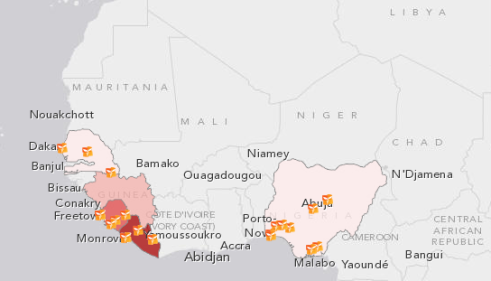
The Ebola Outbreak is taking place in a region with active insurgencies and an emerging terrorist threat, which requires the integration of all-source intelligence analysis from the IC for indications and warning and force protection. The organization within the Department of Defense charged with intelligence assessments of epidemiological threats is the National Center for Medical Intelligence. Located at Fort Detrick, MD, the NCMI is a joint-service component of the Defense Intelligence Agency. With origins in the Army’s campaign against Yellow Fever, and later the influenza epidemic, NCMI is organized into a support division and two substantive divisions—the Epidemiology and Environmental Health Division and the Medical Capabilities Division.
The Environmental Health Division has direct application to the Ebola outbreak through its mission to Identify and assess environmental risks that can degrade force health or effectiveness including chemical and microbial contamination of the environment, toxic industrial, chemical and radiation accidents, and environmental terrorism/warfare.
Additionally, MCMI is the ideal entity to identify, assess, and report on infectious disease risks to the force itself that can degrade mission effectiveness of deployed forces and/or cause long-term health implications.
Summary
The situation is well past the containment phase in Liberia, where the major US military footprint will be located. The key to containment is the application of epidemiological methodology to an all-source analytic capability targeted at the force protection threat as well as the threat to the homeland.
This requires direct connectivity with the Public Health Emergency system, drawing on the basic sector alignment established in the health annex to the DHS National Infrastructure Protection Plan. In that context, we know how to provide emergency medical care at the scene of the contagion, during infectious disease outbreak, and during patient transport and delivery to a hospital or other treatment facilities.
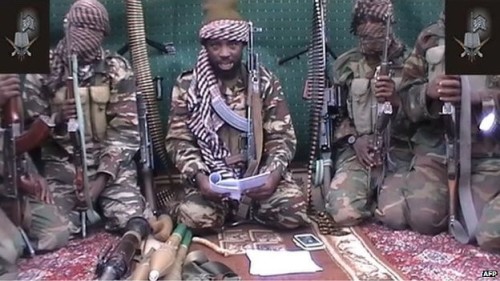
The trick is linking what we do here to the military capability to establish treatment centers where they are needed and add in the military force protection capabilities to the all-source analytic process. Boko Haram is active in the area, and quite capable of exploiting the presence of US forces for terror operations.
Not to mention that they are quite capable of using the Ebola as a weapon of terror as well.
So, this is a multifaceted challenge that we are actually well positioned to address through linked Intelligence Operations systems appended to the National Medical Intelligence Center at Fort Detrick, the Pentagon and the Joint Staff Crisis Action Group (AG), the Department of Health and Human Services, CDC in Atlanta and collateral links to the WHO in Geneva, the Department of Homeland Security and Customs and Border Protection, national governments in the areas of contagion, along with connectivity to host nations, AFRICOM and JIOC Dets with deployed forces. It is those detachments, located physically in the areas of contagion, which will require real-time force protection
They would then be able to provide threat assessments (health and force protection) as well as monitor the three “T’s” of the outbreak: triage, treatment, and transport of all Ebola infections to central treatment points.
We also propose that this network will be responsible for both preparing US and host nation staff, patients, facilities, and environment; providing response teams with the situational awareness on comprehensive medical care and mental health support to patients and their families, comprehensive force protection and indications and warning support to deployed forces. .
We know how to do this- the key is to adapt what we do to a mission that is analogous (epidemiology) with all-source intelligence needed to provide effective response, situational awareness across West Africa, and the potential for global outbreak.
There is also a darker threat inherent in the outbreak of any virulent disease. There are adversaries who could weaponize the Ebola epidemic by deliberately exposing volunteers who hold valid EU/US passports and dispatch them to infect as many people in their home countries as possible.
Directly harnessing our experience with Pattern of Life/Attack the Networks expertise gained in Iraq and Afghanistan will bolster our ability to interdict such plots as they are in progress.
With potential deaths in the millions and the Ebola outbreak uncontained, it is beyond time for a coordinated effort within the US Government between the IC, DoD, the Inter-agency Public Health sector (which includes the resources of the VA), DoJ and DHS components. All can share information via the Joint Worldwide Intelligence Communications System (JWICS), while recognizing that connectivity is not as robust in the public health sector and requires investment.
Parallel fire walled connectivity is required outside the US Government, including Non-governmental entities, host nation defense and health entities, and donor partners. Thankfully, extensive coalition operations over the last decade have eased the intrinsic conflict of interoperability across jurisdictional lines.
The architecture will require careful but rapid development, and the provision of analysts familiar with the parallel All Source and Epidemiology communities.
Haste is required. The threat is real and it is imminent.
Copyright 2014 Vic Socotra
www.vicsocotra.com
Twitter: @ jayare303
The Outbreak
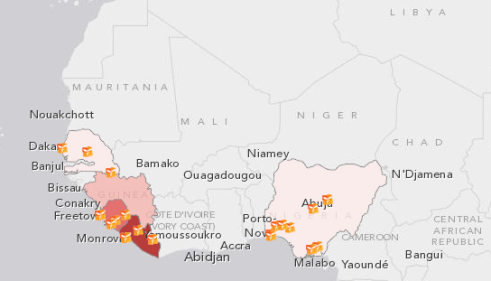
It is scary as hell. The 2014 Ebola outbreak is the largest Ebola outbreak in history and the first in West Africa, with cases being reported in Senegal, Nigeria, Liberia and Guinea. Ebola is an infectious and often fatal disease that results in fever and severe internal bleeding. Previous outbreaks were relatively contained, and the lethality of the disease served to kill its host before it could spread far.
The first noted and attributed outbreak in 1976, in Zaire, killed 88% of the 318 reported cases. Nasty.
There are no medications effective in curing the virus, but this strain appears to be a little less lethal, which paradoxically is not a good thing. Reduced lethality allows it to spread further, and with airline travel it can be a world away before people know they are infected.
The initial response in America was passive-aggressive: activating the Emergency Response Center in Atlanta at the Center for Disease Control (CDC) and deploying medical teams to the affected areas to help coordinate technical assistance and control activities with partners. Three medical missionaries who contracted the disease were brought back to the US for treatment, and in a hopeful note, all three have survived.
Because of the lack of existing medications to combat Ebola, the Department of Health and Human Services (HHS) has contracted with Mapp Biopharmaceutical Inc. to develop and manufacture an experimental drug called “ZMapp,” for early stage clinical safety studies and nonclinical studies. Initial human testing has already begun.
Drug development is a notoriously time-consuming process, and unlike previous Ebola outbreaks, this one continues to spread. As you saw yesterday, the President is besieged by problems overseas. There are the murderous jihadis, in Syria and Iraq, of course, as well as Boko Haram in the areas where the outbreak is centered.
You remember the Boko’s right? They were the religious zealots who think it is appropriate to kidnap hundreds of Christian girls, sell them into slavery, deliver them into forced marriages. They don’t like us, either.
Based on a need to respond to the growing health crisis, President Barack Obama is ordering 3,000 military personnel to West Africa. There they will confront an inadequate public health infrastructure, disordered societies, and m amid worries that the financial and human cost of the outbreak is rapidly growing.
The military response is part of a heightened U.S. role that will include erecting new treatment and isolation facilities, training health care workers and increasing communications and transportation support capabilities to mitigate the spread of the disease.
“Here’s the hard truth,” announced the President. “In West Africa, Ebola is now an epidemic, the likes that we have not seen before. It’s spiraling out of control, it’s getting worse.”
With US forces in the field, there is clearly the danger to personnel from the disease. Add to the fact that there are ongoing insurgencies with some seriously infectious jihadis in the neighborhood, we have the clear requirement for Force Protection intelligence capabilities as well.
I am working on a scheme to do exactly that, laying out the way our public health response system works (and doesn’t) and how we can best support our military as they deploy to the areas where the outbreak is the worst.
It is sort of dry going, considering the stark reality of what we are asked our people to confront. The words go sort of like this:
“Response to Public Health emergencies is provided by a sector-based approach shared between the Department of Health and Human Services and its components (Center for Disease Control (CDC) National Institutes of Health, et al), State, local, tribal, and territorial levels of government.
This generally corresponds to the scales on which emergencies generally occur. On the one hand, the complex and dispersed nature of the sector makes it difficult to disable the entire nationwide system. On the other hand, this presents challenges in coordinating emergency responses across disciplines, regions, and levels of government.”
It is painful to even write that stuff. I spent too many years crafting words to go along with diagrams like this:
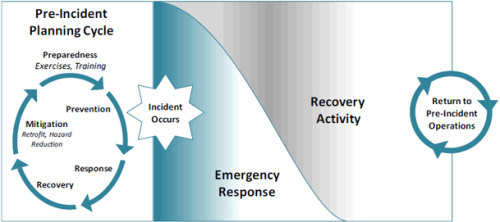
Here is the problem, or at least one of them. We are way past the “Pre-incident Planning Cycle” phase, and well past when the incident has occurred. It is going to be catch-up, and the “recovery activity” can’t even be seen yet.
Off we go again. If there was ever a case for American exceptionalism, this is it.
More on what we ought to be doing tomorrow. Today is calling.
Copyright 2014 Vic Socotra
www.vicsocotra.com
Twitter: @jayare303
Unraveling, with Pan Roasted Chicken Breast with Wild Mushrooms, Andouille and Natural Pan Gravy


I wish I had a legitimate case of writer’s block. I don’t. I have been writing madly since I sat down this morning. I just can’t do anything with it. Thankfully, Marlow came to the rescue. I need to get back to compiling the cook-book.
The topics de jour on which I did not want to think too hard wandered far afield. They included Big Jim Hill and the Sherman Anti-trust Act; the contraction of the Italian Economy; the world leaders who will be no-shows at the Climate Summit; Foreign Policy Follies; aggressive and monstrous crimes conducted in the interest of religion.
You know the issues- and there are a lot of them. They frankly make me weary. I saw a nice piece by Roger Cohen in the OpEd section of the Times yesterday he called “The Great Unraveling.” I still read the Times, though I think the paper has come on hard times ethically, and the First Rough Draft of History has become way too ideological for my tastes.
But I think that Cohen has a clear and unblinking view of what is going on in the wide world. It is coming apart.
I am not going to attempt to dissect the manifold problems- that is tiresome, and we have been down that road before. If you get a chance, take a look at the original article and see what you think.
I would be interested in hearing what you think.
Speaking from a personal perspective, there is not a great deal the ordinary citizen can do. I mean, we are not of the Oligarchy or the new secular Clerisy that imposes their will on us.
Of course we can vote, and I do so with religious fervor. It just isn’t going to do much good against the forces that are in motion. There are so many things that are plainly wrong and plainly evil that must be stopped, but the watchdogs have been silenced and the cops are part of the problem.
We are supposed to ignore what is happening right in front of our eyes. There are new taboos that must never be mentioned. We are told never to give offense, even when what we see is obvious and transparent nonsense. The social fabric is tearing at the seams.
That leads one to the inescapable conclusion that we are going to have to take care of ourselves. I have made the prudent preparations I can. Beyond that, I am at a loss for what else I might do. We have talked extensively about the fact that it is probably beyond time to abandon this outpost in Washington- that is on the menu.
The question is where to go? The farm is a start, I suppose, but there is the matter of the winter to come..
I guess we will go from there and see what the rest of life has in store, and whether the whole thing really does unravel. Oh hell, it is. I think we all know that. The question really is just “when.” What I wouldn’t give to have the answer to that one.
In the meantime, Marlow came to the rescue this morning with a superb recipe for
“Pan Roasted Chicken Breast with Wild Mushrooms, Andouille and Natural Pan Gravy”

Ingredients:
Yield: 4 people
•4 6-8 oz. Chicken Breasts (boneless, skinless – ugh!) (recommend use one big one with skin for two people)
• 1¼ cup Andouille Sausage (or any other good quality smoked sausage), diced small (one spicy one for two people)
• 1½ cup Assorted Wild Mushrooms (Shitakes, Portobello, Oyster, Crimini, etc.), thinly sliced (recommend use baby buttons, if wild one not available)
•½ cup Chicken Stock or Broth (1/4 cup for two people)
• 2 tbsp. Chopped Parsley
• 2 tbsp. Chopped Green Onion (green parts only) (recommend use half a small sweet onion chopped)
• 4 Sprigs Fresh Thyme (try ½ tsp thyme powder)
• 1 tbsp. Chopped Fresh Garlic (try 1 tsp for two people)
• Salt, Pepper, Cayenne
• 2 tbsp. Room Temperature Unsalted Butter
•½ cup All Purpose Flour
• 4 tbsp. Olive Oil
Method:
Some say “Preheat oven to 475°” (way too hot; try 400° for 30 minutes of cooking). In a large sauté pan, heat half of the olive oil. Season the chicken breasts with salt, pepper and cayenne on both sides, dredge in flour and shake off excess. When oil is hot sear the chicken breasts on both sides.
When sufficiently browned, remove from pan, place in a baking dish and put in the oven to finish. Wipe out pan and then add the rest of the olive oil. Add diced Andouille. When fat starts to render, add mushrooms.
When mushrooms start to crisp (about 4-5 minutes), add green onions and garlic and cook for 2-3 minutes. Correct seasoning with salt and pepper. Remove fully cooked chicken breasts from baking dish. Place on serving plate.
Place Andouille/Mushroom mixture on top on chicken breasts. In the same pan, deglaze with chicken stock, add thyme sprigs and reduce by ¾.
Take stock/thyme mixture off heat, whisk in the room temperature butter, correct seasoning with salt and pepper, add parsley, stir and then pour over chicken.
Marlow says: “It was a piece of cake to prepare, and last night’s entree was a surprise of spicy tastes balanced by the Pinot Gris’s light fruitiness – a stark contrast to what is going on in the Imperial City and across the world.”
I think, on the whole, Marlow’s approach is the right way to deal with the unraveling of the West.
Copyright 2014 Vic Socotra
www.vicsocotra.com
Twitter: @jayare303
Major Construction
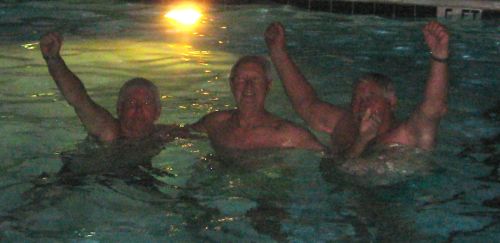
The pool closed last night. It is the official change of the season. The mild summer lacked the squishy moist heat that we usually endure, and had the curious effect of never allowing the water to truly warm up much above 80 degrees all season. That had the practical effect of leaving us practically chilled when we emerged from the water through the hottest season of the year.
They tell us that the old-school pool has “issues.”
It was completed with the building in 1964, so in the great maintenance scheme of things it is an even half century old this year. Leo the Building Engineer tells us there are problems deep under the deep end- corroded pipes on the edge of failure. Major contraction is going to be required to get at them. That is going to require intrusive intervention, not dissimilar to what was required at the Pentagon when they took the interior down to stark concrete.
It is going to be a tough season of broken cement and digging and new pours, so this closing will not have the bittersweet devolution of most years. The flowers will be allowed to die, as they always are. Excess water will be pumped out, of course, spreading the chlorinated flow across the west side of the parking lot and down into the storm drains.
The pool furniture will be collected and stored down in the Life Guard’s room in the basement. After that, I don’t have a good feel for what will happen going forward.
Will all the water be pumped out? We don’t have the risk of the concrete walls of the pool popping up out of the ground, as some renters did to a pal’s in-ground aquatic center in Florida. The routine maintenance became a burden, and they emptied the thing, no knowing it was the weight of the water that kept in in place. Oops!
So I don’t know how vast the scope of this project is going to be, or how intrusive to my personal space it is going to be.
We were talking about it last night, waiting for the Last Leap into the water.
“Suppose they replace it with one of those modern wimp pools that is only about three feet deep?” asked Jiggs.
The Doc is still mad that they took the diving board away a few years ago. “It is always something about liability and insurance,” she said with a frown.
“That’s why we don’t have a roof garden.,” I said. “I have seen the drawings. The roof is designed to support one, and the view is unbelievable. You can see from the Masonic Temple in Alexandria all the was up to District Heights.”
“I have never been up there. Why can’t we go out and look?”
“Insurance. Apparently someone threw themselves off the roof in the 1960s.”
“What is the difference between throwing yourself off the roof and jumping off an 8th floor balcony?”
I shrugged and took a pull from my drink. “I think it amounts to the same thing. But speaking of leaps, I think it is about time for one.”
President Joe and Jiggs and I got up from Joe’s patio table, grabbed our towels, and marched out to formally end the summer.
Jiggs did a cannonball into the deep end as Joe and I synchronized our jumps to de-conflict the impact. The water was warmer than the air, crisp and refreshing. Milla and Margaret took photos to document the event, and I dawdled enough to ensure that I was the last one out.
“Well,” said Joe, toweling off vigorously. “I guess that’s it.”
“Yeah, I just hope there is a pool deep enough to jump into next year,” said Jiggs.
“Time will tell,” I said. “I will be keeping an eye on it.”
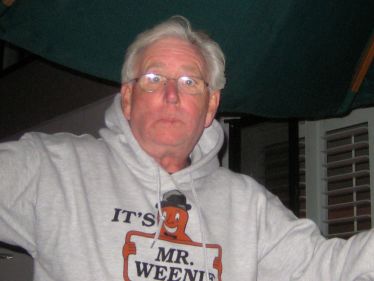
Copyright 2014 Vic Socotra
www.vicsocotra.com
Twitter: @jayare303
Dedication at Sangster’s Station
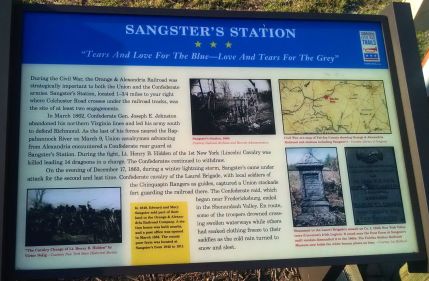
(Civil War Trails Interpretive marker located 1.75 miles from the original site of Stangster’s Station at Caboose Square in historical Clifton, VA. The original monument is at the lower left, with helpful maps and an account of the two actions at the Station in 1862 and 1863, All Photos Socotra).
Steve, the new member of the Historical Preservation Committee with the speaking part, got the Confederates and the Union forces sort of mixed up in the middle of the narrative about the raid on Sangster’s Station, but it was OK. The audience listened with rapt attention in the nave of the Presbyterian Church just up the hill from where the Devereau Station had been located at the time of the war.
The actual site of the raid was just up the track about a half-mile, but you know about the long bitter struggle between the Civil War Trails people and the Virginia Department of Historical Resources People.
They talked about it in the dedication ceremony, the one in which I wished there had not been a delightful bottle of wine with the splendid food at the Clifton Main Street Pub. I resolved, not for the first time, that wine should follow ceremony, not precede it, but sometimes circumstances get away from one, don’t they?
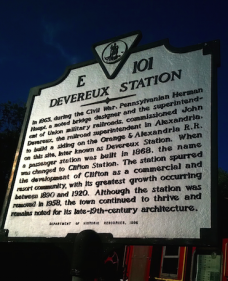
(The iconic shape of the VDOT-approved historical marker that could not be placed close enough for the Preservation Committee to the actual Sangster Station.)
Anyway, the Historic Resources people insist that the aluminum signs be placed on public roadways where they can be seen, and the nature of the old farm lanes that lead to Clifton are such that the sign would have been placed out by Ox Road someplace and make the history be divorced from the location, which didn’t seem to make much sense to the Clifton Historic preservation Committee, or at least to Margo, the chairwoman.
“It is a problem with the VDOT connection, the agency that installs and maintains the signs,” she sighed with disappointment. “The only place they would accept us putting the sign is just too far away from where it happened.”
The Civil War trails people are much more accommodating, and putting the informational signage at Caboose Square, even if it was not the right place, seemed to be a fair compromise, and matched it with the sign describing what happened in the actual place where the Devereau “Wye” had been placed in 1863 so the trains could turn around to head back to Union-occupied territory. They could not run further south due to the presence of hostile forces whose irritation with the Yankees was palpable.
But maybe I am getting a little ahead of myself, and need to back up to the drive in the rain out Braddock Road from the Beltway, and past the place I used to live, and to Ox Road and then the spur off into the old farm lanes that wander past St. Mary of Sorrows Catholic Church, on Fairfax Station Road. The little wooden church was the first Catholic Church in Fairfax County, dating to 1860 and the influx of Irish railroad workers.
Clara Barton, founder of the Red Cross, tended to wounded soldiers in the churchyard there, and the memory inspired her to create the organization.
Then past Fairfax Station itself, a modest little structure with a red caboose on the siding out front that I had never seen before, even though I had lived within a few miles of it for more than a decade.
The railroad my ancestors helped build stayed to the right as the narrow blacktop swirled over hills and followed the terrain. The increase in population with the explosion of development in the County had greatly increased the number of teenaged drivers, who demonstrated an alarming propensity for driving too fast and launching themselves into the trees. Accordingly, the Clifton cops are death on speeding.
In fact, traffic accidents were one of the deadliest things out in this very peaceful country place. Much more deadly than the rumors about the Bunny Man murders at the Bridge, which didn’t actually happen, though the vehicular mayhem was quite true.
When I rolled into town the rain was starting to subside, and the re-enactors of the155th New York Infantry Company I were emerging from their tents and beginning some close order drill for the entertainment of the crowd. David, their Captain, sported a period-authentic long goatee and spectacles under his Kepi, and wore his Colt .44 black powder pistol and Officer’s sword with panache.
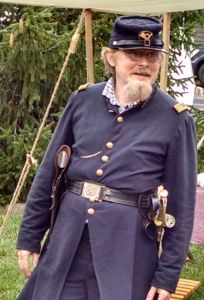
His men fired a couple volleys from their Springfield rifles to the delight of the crowd and it was a grand prelude to lunch in the Main Street Pub and that superb bottle of wine. I can’t recommend the place highly enough. The old general store and Texaco station retained the front end of the old store, but the back has been blown out to accommodate a cozy restaurant and bar. The staff was attentive and fun, and did I mention the wine was delicious?
And then the dedication ceremony, of course. The rain had caused them to move the speeches inside, though the skies were starting to clear as the crowd thronged in. The actual ceremony was delayed, and the musical prelude by Mandolin Jon was extended. You know the stuff he played- Ken Burn’s music from the historical documentary- and the reason for the delay was travel problems on the part of the 17th Virginia Infantry “Fairfax Rifles” re-en-actors.
They did not feel the ceremony should go forward with only the Yankees present. It didn’t seem right.
When the Butternut-clad troops arrived (no provocative stars and bars, only the regimental and State flag) we got rolling with a heartfelt rendition of the Anthem (very near the two hundredth anniversary of the penning by Francis Scott Key over in Baltimore) and a speech by State Senator George, an amiable fellow with orange hair, and a courtly presentation by portly Mayor Bill. Then Captain Dave gave us a brief history of the Buffalo, NY, Irish regiment that had guarded Sangster’s Station that perilous night, and Preservation Committee new-member Steve and his somewhat boggled account of the running gunfire in the storm and darkness, and some marvelous remarks by Chairman Margo with a stirring summation on what happened to the original memorial by the Fairfax City Historian Emeritus Lee.
The plaques had been stolen- preserved?- by a long term resident. “We did not treat it as a law enforcement issue,” said Lee with a smile. “But we knew he had them and approached the family after he died. He gestured at the square bronze markers that had been mounted on the low granite marker behind him. “All’s right in the end.”
Which it was. I wasn’t quite yawning by the time everyone had spoken their piece. Wine after ceremonies, I reminded myself, but was impressed by the level of effort and commitment on the part of people who have lives beyond preserving history. They were all nice people, even the politicians.
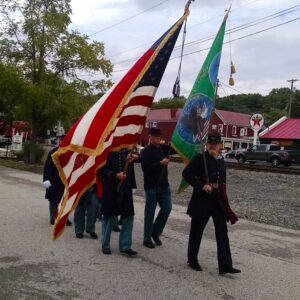
When it was done, we straggled down the hill as the 155th NY Infantry held their banners high. Photos of the Civil War Trails marker were taken with the political folks and the re-enactors in this pleasant little town where history is valued, and time seems to have stood completely still.
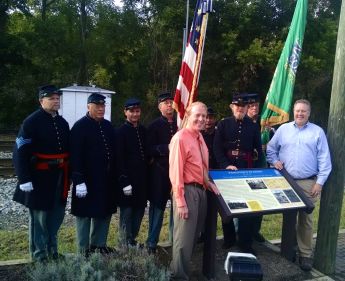
(155th NY Infantry, Co I, State Senator George and Hizzoner Mayor Bill.)
Copyright 2014 Vic Socotra
www.vicsocotra.com
Twitter: @jayare303
Along the O&A
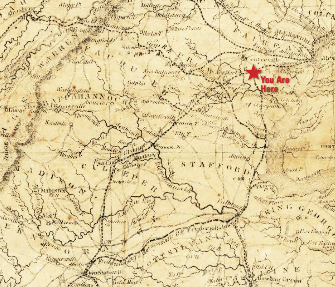
(A vintage chart of the Orange & Alexandria Railroad line through present-day Clifton and down to Culpeper. Image courtesy NPS).
It is sort of strange that one of the richest counties in America, proud Fairfax of Northern Virginia, should only have three actual towns: Herdon, Vienna and Clifton. The rest is partly historic, like Fairfax City with its courthouse, or neighborhoods composed of McMansions and connected by sprawl.
It was the first jurisdiction in America to have an average six-figure income, and ranks number three on the list of richest Counties- with Loudoun, just to the west, coming in at number one. I am thinking about visiting Bunny Man Bridge out there this weekend for a variety of perfectly good reasons, but Clifton is a special little place on the way to Refuge Farm.
It is on the way there, that is, if you are meandering. It is a bit elusive, and it is intended to be that way. Threatened by the oncoming wave of earnest bureaucrats and lobbyists seeking favors from the Imperial City, the developments were cascading west. The town council decided to restrict development, and zoned the place so that each house had to sit on at least five acres of land.
Problem almost solved- what they got was an enclave of older farmsteads and new McMansions. But it is a cute place, affectionately known as the “Brigadoon” of Virginia, as a few folks have thought perhaps it was one of those mythical places that only appears on earth for a short time, every hundred years. One thing is certain, Clifton does exist and looks very much as it did a century ago because the locals want it that way.
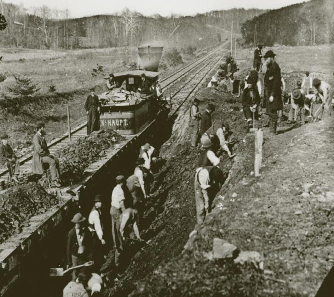
(Union railroad workers building the Wye at Devereux Station, now Clifton, VA. Photo NPS).
I was taking an interest in the place for a different reason, one that occurred 150 years ago, during the late unpleasantness between the states. I like connecting with my Mosby heritage- the Farm sits on the southern edge of the country where the famed Confederate guerilla operated his band of mounted brigands- or patriots, depending on your point of view.
I mentioned that the Irish Socotras were laborers on the Orange and Alexandria railroad after landing at Alexandria in 1848. The line runs through Clifton, ultimately to Richmond and points west from Orange, so I can honestly say that there is a family connection to the place.
During the war, interrupted by the 1863 requirement to pull the Union Army of the Potomac out of Northern Virginia and fight General Lee in Pennsylvania, the US Military Railroad Construction Corps built a siding there, which it named Devereux Station, in honor of Superintendent of Military Railroads, John Henry Devereux.
Devereux Siding was located between the station at Union Mills and Sangster’s Station along the O&A Line.
It was a pretty spectacular process, and rendered the landscape unrecognizable to those of us who think the scrub brush and dense trees of today are the normal landscape. Timber for railroad ties, bridge trusses, and firewood was harvested by battalions of wood-choppers and hauled by teamsters, many of whom were escaped contraband. They risked a lot operating outside the security of Union lines, and were subject to re-enslavement if captured by Rebel cavalry.
In the spring of 1863, a turn-around (known then as a “Wye,” or triangular junction) was built at Devereux Station to enable trains to reverse direction after the decision was made to abandon the O&A line south of Bull Run Creek. By June 1863 the entire railroad outside the Arlington Line was abandoned until the return of the Major General George Gordon Meade’s return from Gettysburg.
New York Infantry regiments were stationed at the siding in order to protect wood station operations and the railroad from Confederate attack.
Upon the Union’s return to the area, Gen. Herman Haupt and his Construction Corps set about repairing the road and the bridges so that the line could again be utilized for military purposes and to support the winter encampment in Culpeper during the winter of 1863-4.
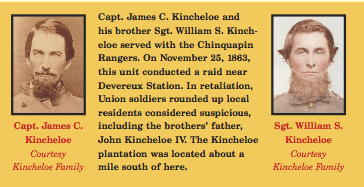
The work of the Construction Corps was made difficult by the almost constant sabotage by Confederate partisan raiders. The Chinquapin Rangers, commanded at this time by Capt. James C. Kincheloe, were responsible for much of the disorder in the area of Devereux Station.
Meade issued a proclamation that thundered: “The numerous depredations committed by citizens or rebel soldiers in disguise, harbored or concealed by citizens along the Orange and Alexandria railroad, and within our lines, call for prompt and exemplary punishment… every citizen against whom there is sufficient evidence of his having engaged in these practices, will be arrested and confined for punishment or sent beyond the lines. The people within ten miles of the railroad are notified that they will be held responsible in their persons and property, for any injury done to the trains, road, depot, or stations, by citizens, guerrillas, or persons in disguise; and in case of such injury, they will be impressed as laborers, to repair all damages. If these measures should not stop such depredations, it will become the unpleasant duty of the undersigned, in the execution of his instructions, to direct that the entire inhabitants of the district or country along the railroad be put across the lines, and their property taken for Government purposes.”
– Geo. G. Meade, Major General Commanding
In mid-July 1863, the 155th NY Infantry regiment was assigned to guard duty at the Siding, to protect construction workers. Meade’s proclamation did not have much effect.
According to the sign they are going to dedicate today, “A notable engagement during this period occurred on December 17, 1863 when Confederate General Thomas Rosser’s entire brigade of about 1,000 men attacked the railroad bridge guarded by the 70 or so men of Company I. After a sharp fight in a thunderstorm in the dark, the Rebels withdrew leaving the bridge and railroad intact despite the fact the Company I was outnumbered by better than ten to one. During the fight the Confederates captured and burned the camp of Company I, leaving the men to spend several days in December without adequate clothing and shelter.”
To commemorate the dedication of the sign, there are going to be re-enactors there in the uniforms of company I, 155th NY, demonstrating how Civil War troops lived in the field, free prizes for the kids and stuff like that. Could be fun, and a chance to see a place where the family labored, briefly.
It is a little piece of history that is worth commemorating, and helps to remind me that despite the depressing things that are going on around us, there were times when it was a lot worse.
In fact, along those lines, I could tell you the ghost story about Bunny Man Bridge that commemorates several savage murders that actually didn’t happen. But we are clearly not going to get to that. The pool is open today and tomorrow at Big Pink, and I don’t care if it is raining or not.
A Man has to swim, right?
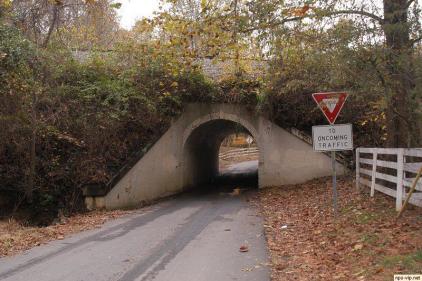
(The famous Bunny Man Bridge, allegedly the site of gruesome crimes. The Socotras helped built the railroad that crosses it, and may have helped inspire this local rhyme:
“Little bunny Foo Foo
Went hopping through the forest
Scooping up the field mice
And bopping them on the head”).
Copyright 2014 Vic Socotra
www.vicsocotra.com
Twitter: @jayare303
SOCOTRA ROCK
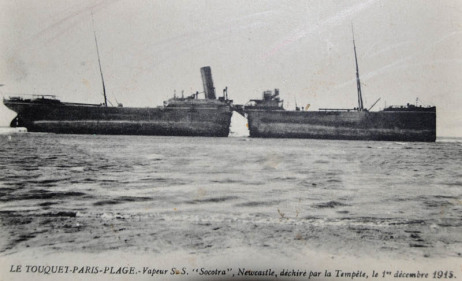
(The SS Socotra as she was in December of 1915, with sampan amidships. Photo Le Touquet-Paris-Plage).
The day passed without anything happening. Well, wait, let me rephrase that: the day passed without anything awful happening to rival what happened thirteen years ago. I am sure something nasty went on somewhere; it is the nature of the world in which we live. Better said, we are not aware of anything that is a clear, unambiguous and imminent threat to the homeland.
Which is also a matter of whose homeland you are talking about.
As dual-nationals, it is important to draw the distinction. The Socotra clan naturally has close ties to Great Socotra Island in the approaches to the Red Sea. Our Irish ancestors wound up shipwrecked there out of no fault of their own, and they were rescued by the British-flagged SS Socotra, out of Newcastle-on-Tyne. She was engaged in the bulk cargo trade, and steamed the old Pacific & Orient (P&O) routes between Britain and the Raj.
Having been once exiled from the Auld Sod, it was no great leap for the hardy Irish refugees to simply stay at sea. The SS Socotra also plied the general trade routes of the Pacific- and it was on a voyage there in 1900 that Seamus Socotra made international history- and identified the next potential flashpoint in the much-ballyhooed Pacific Pivot and the Geopolitical Battle of the Titans over jurisdiction (and the resources under) the East and South China Seas.
It happened this way: Seamus was an able enough seaman, passing through that rank periodically on his way to mate before some liberty incident would have him busted back down to seaman. At this particular moment he was reduced to mess cooking, based on a regrettable misunderstanding ashore with some Korean barmaids in the lovely port city of Busan.
Carrying slops in a bucket to throw over the side, he was making heavy going in the steep seas that tossed the steamer. As he kept on hand on the ship, and one on the bucket, the trough of a gigantic wave swept alongside, and in the very bottom of the trough an ominous black rock was exposed.
“Sweet Mother of Jeasus!” he exclaimed, and the slops, bucket and all, disappeared into the angry sea. Seamus made his way swiftly to the bridge, where he breathlessly explained his discovery to the Captain, who promptly directed the Navigator to enter the location on his chart, and to christen the rock, normally concealed as much as fifteen feet below the waves, as a hazard to navigation that could rip the keel out of a stolid merchantman.
Socotra Rock became the stuff of legend, once the Captain reported the discovery to the Admiralty at HMS Tamar when the merchant called at the Crown Colony of Hong Kong a week later.
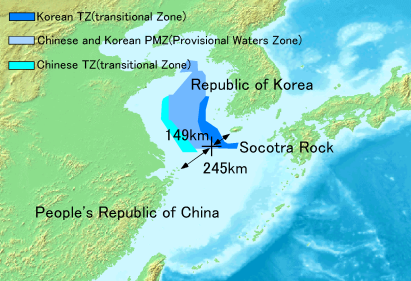
The rock is located roughly 90 nautical miles southwest of the Korean island of Jeju-do, which is redundant, since of course “do” means ‘island’ in Hongul, the national language of Korea. Use of the language irritated the Japanese no end after they began the long annexation process of the Peninsula in the Meiji Restoration. Ultimately the Japanese attempted to stomp out the language altogether as they established a protectorate in 1905, after the Empire of the Sun defeated the Czar’s Navy at the Battle of Tsushima. Outright annexation followed in 1910, along with the compulsory teaching of Japanese.
That is just another of the reasons relations in Asia are strained. Memories of old grievances run deep, like those of the Irish.
Seamus eventually took his sea-bag ashore in New Jersey, which is another story altogether. But what he saw seemed to confirm a legend told by the phlegmatic fisherman of Jeju –do. In their accounting, there was an invisible island to the south where the spirits of fishermen who perished at sea went to dwell. The mythical island was called both “Parangdo” and “Ieodo,” since they did not know that Seamus had claimed it- and named it- for himself.
I only bother to bring this up now because Seamus’s Socotra Rock has become an issue in the ongoing struggle for submarine resources between former Imperial power Japan, Rising China, and a cranky Korea.
Last Sunday, the government of the Republic of Korea announced that it extended it’s Air Defense Identification Zone (ADIZ) to include Socotra Rock, where the ROKs (no direct relation) in 1995 had erected an observation platform and helicopter pad.
The Korean air defense zone now overlaps with the air defense zones already claimed by both China and Japan and this dramatic development is expected to increase tensions in the region. Both Korea and China had already claimed the rock as part of their own “exclusive economic zones,” (EEZ), though the Rock is much closer to Korea than to China.
Everyone knows there is a trove of resources beneath this blue waves, and jurisdiction means a lot- perhaps even enough for a naval conflict that could involve the de facto guarantor of the peace, the United States Navy.
Tensions are rising, and a dispute between South Korea and China over a remote rock has prompted a tense exchange of words between the two countries. Ambassadors have been summoned and stern letters exchanged. There could be more to come. In fact there could be much more.
I do not think that either of the parties realizes the full implications of all this history. Socotra Rock belongs to me. My family saw it first.
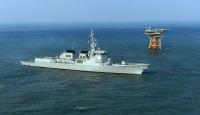
(ROK AEGIS-DDG Yolguk Yiyi at Socotra Rock. Photo ROK Navy).
Copyright 2014 Vic Socotra
www.vicsocotra.com
Twitter: @jayare303
Thirteen Years
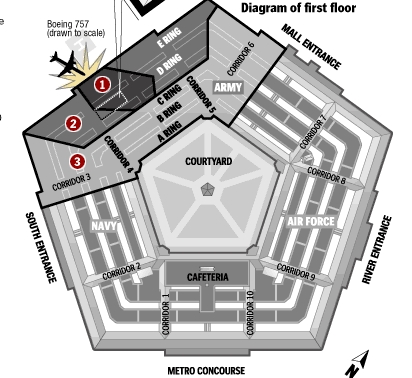
I wrote the date and then I had to stop. Thirteen years, almost to the tick of the clock. I watched the President last night, and I know only one thing: we are not safer today than we were then, and this is a mess. Despite all the blood and treasure we have spent since The Day, we have not made it so.
I have notes in my work journals from that summer a baker’s dozen years ago. There was a sense of dread abroad in the land for those of us who had to think about; there were things that had happened that made another awful incident inevitable.
There was enough already to be uncomfortable about. The Embassy bombings in East Africa- I had a pal who was in the basement of the one in Nairobi when the truck bomb went off. The World Trade Center garage bombing. The USS Cole attack. All the way back to the Beirut Embassy bombing, where my shipmate Wheels was killed.
I took it all a little personally, but nothing like what I was going to be feeling on that beautiful September day.
I had stopped by the office of the Director for Plans on the Intelligence Community Staff one day not long after I left the Pentagon to work at Langley, and plopped down on the chair across from Deborah’s desk. Her windows looked out of the Original Headquarters Building on the sixth floor over the trees.
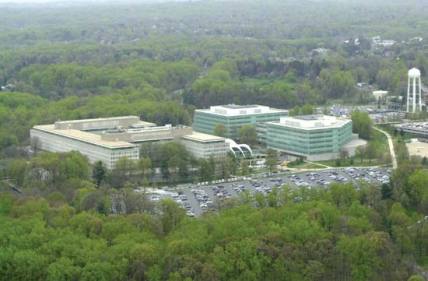
Langley is a pretty campus, very pastoral.
“You know they are going to smack us, right?” She nodded. We all knew something was coming. I have the notes: “Tel Aviv, New York? What’s next?” reads one note from July of 2001.
On that particular morning, I happened to be staying in the Walter Reed BOQ on Fort Leslie J. McNair in SW DC. It is an old brick structure, built to the standard plan of the 1880s Army. It was a drafty building with small rooms and doors that did not quite fit the frames anymore.
In keeping with the pre-air-conditioned era in which it was built, each floor featured a broad veranda accessible from the central hallway. There was a splendid view of the Potomac from the east, and the vast low sandstone bulk of the Pentagon across the river.
The Community Management Staff does not rise early, and I could have adjusted my hours later. Old habits die hard, though, and I was up at five on that Tuesday morning to shower and shrug on my tropical whites with the four gold stripes on the shoulder-boards, full ribbons and the identification badge of the Joint Chiefs of Staff below.
I could have worn civvies; CMS was not much of a stickler for military precision, and living with the Agency we did, was more than accustomed to people not being exactly who they pretended to be. Plus, traveling light as I was at the time, not having to worry about a full wardrobe was a convenience.
I walked down to the car, to head for the office just like the assholes who were about to change our world. I put the top down on the car; it was beautiful in the pre-dawn. The inky sky was illuminated by a elegant silvery moon, no clouds. The temperature was perfect.
I drove out Maine Avenue to catch the 14th Street Bridge and cross over into Virginia. The campus at Langley is best accessed by the George Washington Parkway, and the spaghetti of roads around the Pentagon is confusing enough even for the veteran DC driver.
I took the Pentagon exit, since I knew that way to the Parkway better than any other from the eight years I worked there. I drove up Boundary Channel Drive, past the River Entrance to the Building. Lady Bird Johnson Park is to the east, across the little stream that is actually the boundary between the District and Virginia.
The great mass of the Pentagon was lit by moonlight, and just starting to come awake with the business of Defense. I passed the wide swath of the North Parking’s sprawling asphalt, and then arced onto Route 27 to hook up to the Parkway.
All I recall, smoothly passing under the leafy limited-access road was the pleasant quality of the air against my skin. There was nothing remarkable about the exit onto Dolly Madison to approach the campus from the east.
The passage through the gate on to the campus was uneventful; the black-clad guards were mostly recruited out of Marine Embassy Guard detachments overseas and were crisp and professional.
I got a decent parking place, a perk of arriving early, and badged in and took the elevator up to the office suite on the sixth floor. I forget whether I had to unlock the vault; normally I did, being one of the first ones in.
That would have been about the time that assholes Mohammed Atta and Abdulaziz al-Omari passed through security at Portland International Jetport in Maine to connect to Los Angeles-bound American Airlines Flight 11 at Logan in Beantown.
I did not have a window in the suite on the 6th floor, but did have my own office, so I did not see how pretty the light was coming up on the trees outside as Marty and Rock arrived in their shared space across the passageway to continue the agonizing process of coordinating a DCI-level directive through the fractious and uncooperative interagency with other members of the Community.
Seventeen other assholes cleared security checks at Logan Airport, Newark International Airport, and Washington Dulles Airport as we got ready for a day of bureaucratic process. Even though some of the assholes aroused suspicion at security screening, none were prevented from boarding their flights.
We were talking about some nuance in one of the paragraphs in our document in our morning huddle that started at 0830 sharp. We were already well into it when Steph came down the hall, announcing to all within earshot that an airplane had hit one of the towers of the Trade Center.
“Jesus,” I said. “Remember, though, this has happened before. A B-25 bomber flew into the Empire State Building during the war.”
Marty and Rock looked dubious, and the conversation about the objections that Fort Meade had to our document was suspended. News of the second crash was in real time, what with attention glued to CNN in the offices that had televisions.
“That’s it,” I said and shut my notebook. “We are under attack. You guys get out of here and get home.” They were both retired officers, contractors now, and they left with alacrity, to spend the next several hours in their cars in the mess of the entire Federal Government attempting to flee.
I went back to my office to wait for whatever was going to happen next, numb. The Boss stuck her head in minutes later to tell me that, since I was wearing a uniform, there was a plan for these sorts of things and we were going to execute it.
That was about the time my pal Eileen was sitting in her car on Rt 27 waiting to get through the jam to Memorial Bridge and get to her job in the attic of the Capitol when American Flight 77 flashed downslope from the direction of the Navy Annex on the hill, over her car then the heliport and into the Pentagon.
My pal John was blown out of his office in 3C265, across the corridor and at the bend of the building from the point of impact near the heliport.
When the images came on the CNN the camera angle made it plain that the aircraft had gone into the area where my old office had been moved in the big re-construction project. Flames rose from the sandstone below the roof. I tried to call my old number but all circuits were busy.
We were moving at that point, to a secure location on the campus, and I found myself with the Director and at a desk with a phone and nothing else.
“Get me the Director of NSA,” said George, and turned back to watch the CNN coverage as the unimaginable happened. His face went gray, gray as the plume of dust that was billowing from the disintegrating tower.
I had no phone book. I do not know how I got through to Fort Meade, but I did. “There is another airplane out there,” someone said. “They say it is coming here.”
I later heard everyone in town thought the same thing, from the White House to the Department of Agriculture.
You know the rest of it, and by then I was just another person watching television like you. Once the realization came that everything was grounded, except Air Force One, they realized that phones without phone lists were no good, they let us go back to our offices.
The Real Plan was going into effect, the one no one talked about, and the Grownups were disappearing. I shuffled paper at my desk until sometime after a lunch that did not happen. I dialed cell numbers randomly to see if any of my co-workers at the Pentagon had survived. I finally got a call through to my old staff.
A pal said she had seen the fireball out the window, but the office was intact, and everyone had got out safely. I was bathed with relief and the sour scent of adrenaline.
The Boss was maybe mobilizing with The Plan. She did not need the three or four us still in the vault. “There will be plenty to do tomorrow. Rest up, if you can. Go home.” she said. I did not have one, and I did not know if it would be possible to get back across the river to Fort McNair. I felt lost and more alone than I ever have.
As it turned out, the drive to the District, past the largest crime scene south of Manhattan, was a piece of cake. There was no traffic on the Parkway, and I saw people roller-blading on the bike path. It was a beautiful day.
I had a big bottle of Popov Industrial Strength Vodka back in the room, and I was able to knock back enough of it out on the stately veranda, watching the soldiers swarm around on post, and as darkness came on, the bright orange of the Pentagon burning across the Potomac.
In my relief that my old office had survived, I discovered that the Navy Command Center had been at ground zero, and Vince and Dan and the other kids from ONI who worked the intel watch were still in the building.
Damn.
The Boss was right. There was plenty of work to be done, and it is not done yet. There is a ceremony at Arlington this morning, but I normally stop by later in the day, when the people have departed and I can pay my respects privately to those who rest so close to where they were martyred.
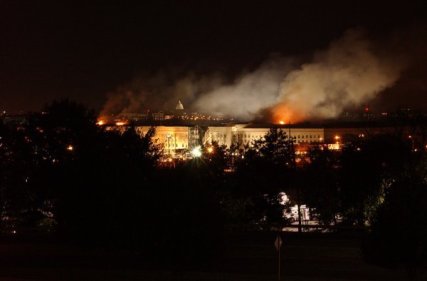
Copyright 2014 Vic Socotra
www.vicsocotra.com
Twitter: @jayare303
Due Diligence
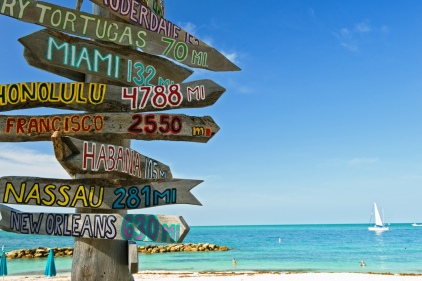
I have a homework assignment. It involves tracking the cost of living, winter mean temperature ranges, and proximity to military facilities that have health, commissary, Class Six and PX stores.
I mentioned before that if this winter shapes up to be like the last one, I intend to spent it elsewhere.
I am not sure where. As you know, I adore Key West. I like the people, the places, the history and the social culture. I am not completely convinced that my personality is not perilously close to being in complete accord with the place- which could lead to The Chief Petty Officer Syndrome.
You perhaps have heard of it. The crusty old chief looks around at retirement, thinks about the cheapest, most fun port he ever visited, and decides to retire in Subic Bay, Republic of the Philippines.
There he gets a lavish place to live at ridiculously low prices, and his modest retirement goes a long way to provide attractive women to date, cold beer in vast quantities at the Fleet Reserve, and a life expectancy that is measured in months rather than years.
I am not saying that would happen to me in Key West, but I will aver that there is no place I have not felt more comfortable in ordering a drink before noon. So I may defer the winter there, or actually just commit to it.
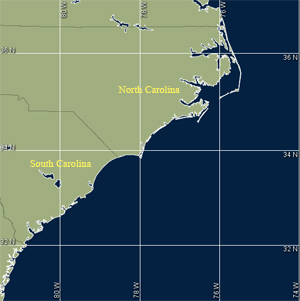
I am obligated to conduct the due-diligence process though, and there were some intriguing options along the Carolina Coast that I wanted to explore on the drive to the Keys. My correspondent in Cajun Country commented: “South Carolina tracks favorably with the Gulf Coast for low cost of living, so I guess you can’t go wrong.
“Climate-wise, the South Carolina Coast is a bit colder than Gulf by maybe 5 degrees or so on the average temperature, but still, the January average (average of high and low) is above 45 F. Mississippi Gulf Coast about 54 F.”
“Typical January high on Hilton Head 56 F, while the coast from Bay St. Louis, MS, to Biloxi is 62 F. Southeast Louisiana, south of Lake Pontchartrain, runs about 2 to 3 F higher than Miss. due to lake effect.”
“But the most livable spot is the New Orleans Metro area. Of course it has the crime and traffic problems common to all large cities. Still, if you pick your neighborhood carefully many retirees are very happy in the Crescent City metropolitan area.”
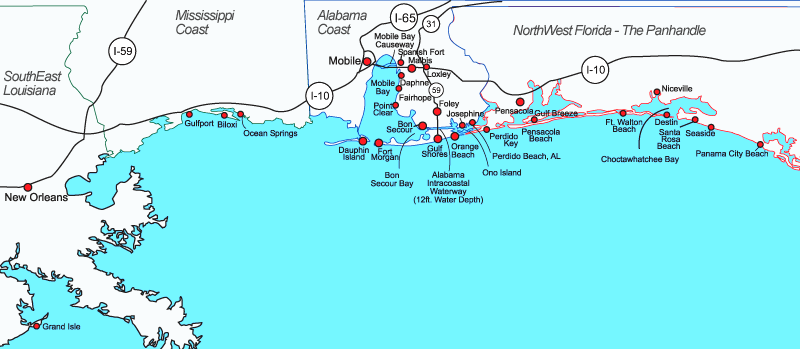
I took a look at the map. The Mississippi Gulf Coast runs about 65 miles east (Bay St. Louis) to West (Biloxi / Pascagoula) Extreme East and West ends are semi-wilderness,
My pal continued his travelogue on the Redneck Riviera: “The cities, villages and towns are about 30 miles from Bay St. Louis to Pascagoula, U.S.Hwy 90 (speed limit usually about 45 mph. It’s like a big beach front boulevard, rather than a “highway” that connects all into one elongated beach front community.”
“If you are in a hurry, you can jump up to the I-10 and by pass the beach at 70 mph and drop down on your destination but typically you’ll travel a good 6 miles father and the ride isn’t as pleasant as poking along the beach at 45 mph and traffic even on peak season weekends is rarely anything to contend with.”
“The military installations are just a few blocks off the beach, lots of shopping including the regions biggest mall are on the beach. When we last had recreational housing there we rarely saw any reason to not take the beach road. The beach road makes every errand a scenic drive.”
“Bay St. Louis and Pass Christian are two of the best places on the eastern end. You might find some real deals in Long Beach but the elevation is very low near the beach. Bay St. Louis and the Pass were hit hard by Katrina but have modest bluffs down on the beach. Some of the homes on the highest points escaped damage.”
“From either Pass Christian or Bay St. Louis you can explore Metairie as an an easy day trip. Also the “North Shore” settlements of St. Tammany Parish across the lake from Metairie/New Orleans are an easy day trip to explore Mandeville, Madisonville, and scenic somewhat waspy and a bit inland Covington. If you come in January and you stay a couple of weeks you will see some of the best and worse of our only full “winter” month.
“That’s important. We are expecting below normal temperatures this winter but that still means that there are good golfing, sailing, outdoor tennis days as well as some cloudy rainy chilly days.”
“We may also see some 20-or-30 year record events like a snow dusting since the Atlantic has started its 30-year surface temperature inversion and we’ve been told to expect a return to the temperature regime of 1945-75. In that time frame, we still averaged 63-43 in New Orleans, but made the average with a few 80-degree days in January interspersed with some record cold.”
“Between 1945 -75 the Central Gulf experienced at least 6 snow dustings, and a single one-inch snow fall. Twice in the 60s we had two periods of daytime subfreezing temps lasting nearly 48 hours each. By contrast prior to last years record cold we had about 3 winters completely frost free”.
“What I’m driving at is that you need to experience the climate at its worse to avoid buyer’s remorse. This is a palm tree-lined semi tropical coast but “semi” means long hot tropical summers a long slowly descending Fall that can bring some fall like weather, peaks out in January and then melds into a rapidly warming spring with summer again setting in about April.”
I wrote my pal back immediately to thank him, and tell him I have some homework to do. I think it is important to conduct the complete due-diligence process. I will not include the Republic of the Philippines in the search for all the logical reasons. Key West is close enough.
I think I will start right after Thanksgiving, you know?

Copyright 2014 Vic Socotra
www.vicsocotra.com
Twitter: @jayare303
